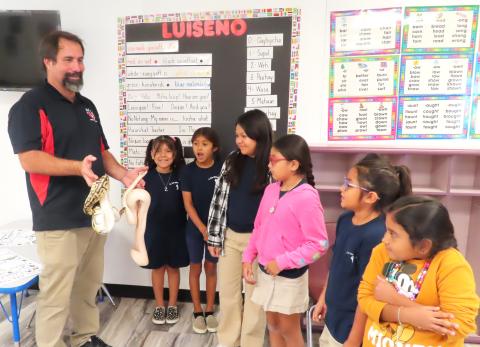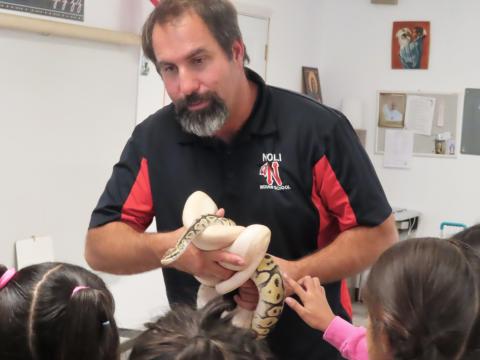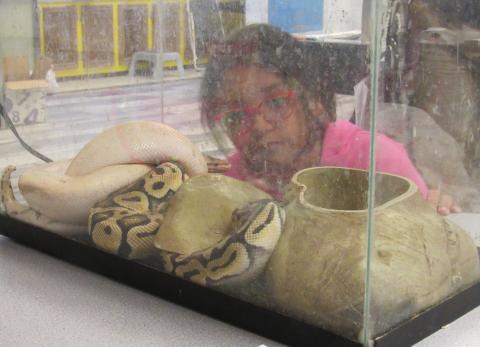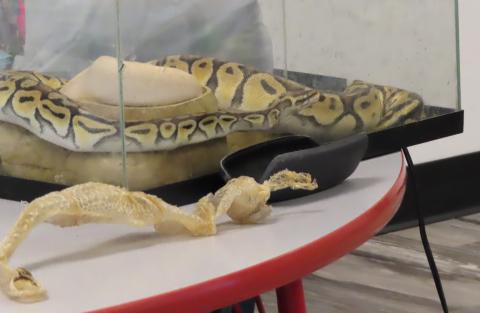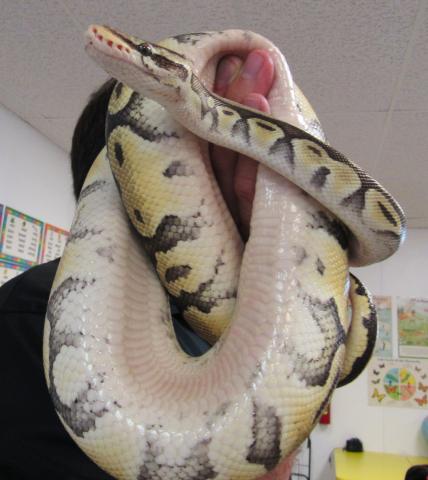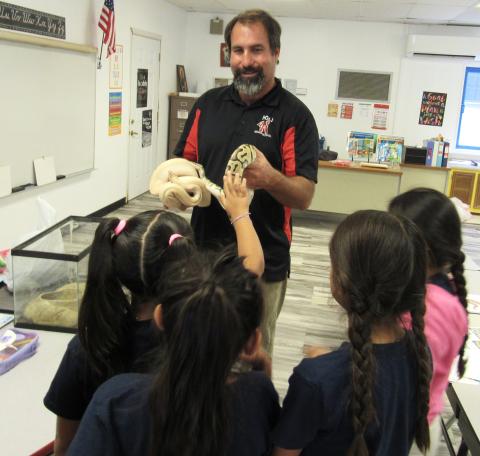After staff at the St. Jude Mission School on the Soboba Indian Reservation noticed an influx of snakes during the recent warm weather, a lesson on snakes was arranged. Science teacher Jay Dagostino from the nearby Noli Indian School was invited, along with his two pet snakes, to give a presentation on safety and awareness.
The school, which shares a campus with the St. Joseph Catholic Church and has WASC Accreditation and WCEA Certification, serves first through fifth graders and currently has seven students. The small student-teacher ratio allows for more in-depth and one-on-one instruction as well as the flexibility to invite guest speakers to share timely topics.
“We try to tie in real-life experiences as much as possible,” said Donna Ferry, who has been at the school for five years. She was a volunteer for the first year, became principal the second year and added teaching first and second grade in her third year. She has been a primary grades teacher for 30 years. “We have had Michael Madrigal teach the students about native plants and how some are used for medicine, how to care for creation, and he also did bird singing and dancing with our students. Kim Marcus teaches our students their Luiseño Language. Fr. Earl Henley, Fr. Tom Burns and Sr. Gen Sarigumba talked to our students about their journeys entering religious life.”
On Aug. 30, students met in Ferry’s classroom. The other class, with students in grades 3-5, is taught by Jessica Martinez who is a first-year teacher who wanted to teach in a small Catholic school. Ferry said they work as a team to come up with ideas and decide what they will do to augment their students’ learning experiences.
Dagostino arrived with a small glass case that held his two pet ball pythons and generated excitement among the students. After removing them from the case, most were hesitant to approach them until he explained the difference between his tame pet snakes who are used to being around humans and those seen in the wild that could be dangerous. Once they warmed up to the cold-blooded reptiles, almost all the children were willing to touch them while they were held by Dagostino. Ball pythons are not indigenous to the local area but they provided a great interactive experience.
He shared facts about the reptiles as curious students asked questions. Snakes use their tongues to smell by way of glands inside their mouths that help them smell and taste. They also have a row of pit glands above their mouths that allow them to “see” infrared images that tell them if something is warm- or cold-blooded. “They can see movement, but their actual vision is not that great,” Dagostino said. They don’t have eyelids, but a layer of skin protects their eyes since they are open all the time, even when they are asleep.
“When they grow, they shed their skin,” he said, while sharing a couple of examples left behind from a recent shedding of his pets, Gold and Princess Jasmine. Named by his young daughters when they joined the Dagostino family more than 10 years ago, the snakes live in a large aquarium in a detached garage at their Fallbrook home.
Explaining that gopher snakes and kingsnakes are the most common ones seen in the local area and are considered good snakes as they keep rattlesnakes away, he warned the children against ever approaching or touching any snake in the wild. Red racers, or coachwhip snakes, are also seen locally and although they are not poisonous, they can be aggressive and bite. Any snake bite needs to be addressed by medical professionals immediately.
“There are some rattlesnakes in the area and they are poisonous so be aware of your surroundings,” he said as he cautioned the children to watch where they are walking as the reptiles can be camouflaged in high grass and behind rocks. He added that we would be overrun with rodents without snakes and hawks and others that prey on them. “Everything has its place in the world, and a purpose one way or another, and we need to understand and respect that. If you avoid them, they will avoid you,” he said.
Staff member Linda Sheehan added, “All God’s creatures are here for a reason.”
Dagostino also supplied a detailed handout that described in pictures and text some of the different types of snakes found in Southern California and their characteristics, noting that most species are harmless to humans. He adapted his presentation to the younger audience and found them to be very intelligent and well behaved. St. Jude students are currently studying food webs/food chains, so they were interested in knowing what snakes eat, which are mostly rodents, small birds and eggs and some lizards.
“I am lucky to have great administrators that allow me the flexibility to share lessons with other students outside of Noli during my planning period,” he said. “I really enjoy the energy and enthusiasm of the younger students. It makes teaching them very exciting. And I always look for ways to make science fun.”
While a few of the girls were eager to get close to Dagostino’s pet snakes, one said she was glad she faced her fear and petted them. Even those that kept their distance were inquisitive and learned important facts they did not know before the visit.
St. Jude students do not need to be Catholic or Native American although the majority of this year’s students are Soboba Tribal members. Children can be enrolled at any time.
“Catholic or not, our students do learn about the Catholic faith and attend school mass every Tuesday,” Ferry said. “They participate in the readings at Mass and participate in altar serving.”
Antonia Venegas, from Soboba, has been a St. Jude school board member for the past four years. She has two children who attended the school and are now students at Noli Indian School. Her son Kevin is in ninth grade and Samuel is in sixth grade. She found public schools to be overpopulated and welcomed the one-on-one instruction her sons received at St. Jude which helped them get on track with their grade requirements.
“The school has changed tremendously,” she said. “They are now WASC accredited, and they added Luiseño language instruction.”
Board members get regular updates on the school and children and put policies in place as well as research grants and ways to better improve the school.
“The thing I like most is that the children get a lot of one-on-one, and they are introduced to the Luiseño language,” said Venegas, who also sits on the Noli Indian School board. “Sitting on both boards gives me the opportunity to introduce policies and add anything to St. Jude that they are lacking. A lot of times I’m able to include St. Jude in with Noli’s activities. Because St. Jude is such a small school, we were able to include them with Noli’s lunch program as well.”
Camille Diaz, who has been Noli’s School Nurse for several years and is also a Soboba Tribal member, has served on St. Jude’s board of directors for more than three years and has grandchildren who attend the school. She said the school has changed in many ways in recent years.
“One being that there are smaller classroom sizes, which helps our children get all the attention they are not able to get in public schools,” she said. “Our administration has changed, and we were blessed with our new principal Miss Donna Ferry who works very hard with our parents and children to keep them moving forward to a great education. My favorite part of the school is the religion and Luiseño language classes that the students receive.”
Diaz also appreciates the ambition and eagerness of all the staff and teachers, who work so hard at helping the students achieve their academic skills, religion and Native Culture goals.
As a board member, she also gets to help plan events and fundraisers for the students but said her favorite thing to do is watch her grandchildren participate in church events. She said the recent presentation on the dangers of poisonous snakes and how to recognize different types was very well received.
“It is very special to have moments like this for our students,” she said. “The students really enjoyed having Mr. Dagostino visit and are hoping he can come and do more classes in the future.”
Ferry said her favorite part of the day is first thing in the morning. “We gather each morning to begin our school day with Morning Prayer,” she said. “We do the Morning Offering, the Prayer to St. Kateri, students offer up prayers to loved ones and things happening in the world, we do the Pledge of Allegiance to the flag and end with the Prayer to St. Jude.”
St. Kateri Tekakwitha is the first Native American to be recognized as a saint by the Catholic church, canonized by Pope Benedict XVI on Oct. 21, 2012. She is the patroness of ecology and the environment, people in exile and Native Americans.
“Since we are a very small school, we are able to work one-on-one with our students and make sure they are all learning, which will help them be successful,” Ferry said. “An advantage for the students to have a Catholic-based education is that we teach our students that God loves us no matter what, and that we are never alone because God is always with us. We teach about loving God, others, and ourselves.”
Tickets for an opportunity drawing on Dec. 7 to win a 2023 RAV4 Hybrid XLE and support the annual Diocese of San Bernardino Bishop’s Golf Classic are currently available for purchase at $10 each. The school receives about $7.50 for every ticket sold and parents who sell tickets will get $3 towards their tuition for every ticket they sell. To purchase, contact Ferry at 951-380-6184.
The school hosts a Pancake Breakfast on the second Sunday of each month from 11 a.m. to 1 p.m. at the Kateri Center, 23600 Soboba Road, San Jacinto. The cost is $5 for pancakes, sausage, juice or coffee. For more information about St. Jude Mission School, please visit www.saintjudeschoolsob.wixsite.com/soboba or email saintjudeschool.soboba@gmail.com.
Photos courtesy of the Soboba Band of Luiseño Indians


